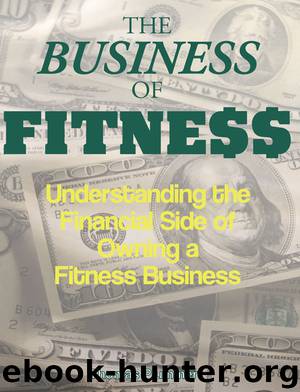The Business of Fitness by Thomas Plummer

Author:Thomas Plummer [Plummer, Thomas]
Language: eng
Format: epub
ISBN: 978-1-58518-853-6
Publisher: Healthy Learning
Published: 2011-08-14T04:00:00+00:00
The goal for club owners is
to keep the club’s long-term
debt service at less than
10% of the BOE. Long-term
debt is anything that is
longer than five years.
The goal for club owners is to keep the club’s long-term debt service at less than 10% of the BOE. Long-term debt is anything that is longer than five years.
The club’s short-term debt structure, which is usually high-interest debt with a three-year or less payout, was only $1,260 a month representing a small equipment lease. The goal with short-term debt is to keep the total less than 5% of the monthly BOE. The ultimate goal for a mature club going into its third year is to have a combined debt structure of less than 15% of BOE. This club was nearing its second year and had a combined debt structure of around 10%.
Clubs can handle long-term debt of about 10% or less as an ongoing part of its operational expense. The short-term ratio, however, should be limited to about 5% of the BOE during the first three years of operations and then be reduced after that point as the club gains the ability to obtain long-term financing.
However, the club had a problem with its balance sheet. Due to lack of owner attention and a recent cash-flow problem, the club was showing payables of about $50,000, most of which were somewhere around 45- to 60-days past due. The club’s cash reserves were also dwindling and were less than $30,000 since the owners had taken most of the cash during the divorce.
Step 10: Percentage of deposits from multiple profit centers
This club had done well with profit centers, especially in personal training, nutrition, and supplements. During its first year the club had averaged between $4.50 and $7.00 in profit center revenue per member workout, exceptional numbers for a club of this size. These numbers had started to decline, however, with personal training dropping from a high of $20,000 per month to less than $12,000. Supplements, munchie-bar sales, and nutritional programs had dropped accordingly as personal training declined. The club was currently averaging less than $2.00 per day per member workout in profit center income.
Step 11: Positioning in the marketplace and other factors
No new competitors had come into the market since the club had opened. The club had three other coed facilities in its five-mile ring and one women’s facility. The club’s lease was below market value and had five years remaining on the initial lease as well as two, five-year options at CPI with a cap of 3%.
Step 12: Payroll and operating costs
Download
This site does not store any files on its server. We only index and link to content provided by other sites. Please contact the content providers to delete copyright contents if any and email us, we'll remove relevant links or contents immediately.
Pioneering Portfolio Management by David F. Swensen(6253)
Man-made Catastrophes and Risk Information Concealment by Dmitry Chernov & Didier Sornette(5951)
Zero to One by Peter Thiel(5730)
The Motivation Myth by Jeff Haden(5174)
The Miracle Morning by Hal Elrod(4675)
Elon Musk by Ashlee Vance(4082)
The Art of Persistence: Stop Quitting, Ignore Shiny Objects and Climb Your Way to Success by Michal Stawicki(3637)
Unlabel: Selling You Without Selling Out by Marc Ecko(3623)
Delivering Happiness by Tony Hsieh(3394)
Urban Outlaw by Magnus Walker(3365)
Purple Cow by Seth Godin(3161)
Mastering Bitcoin: Programming the Open Blockchain by Andreas M. Antonopoulos(3009)
The Marketing Plan Handbook: Develop Big-Picture Marketing Plans for Pennies on the Dollar by Robert W. Bly(3005)
The Power of Broke by Daymond John(2931)
The Content Trap by Bharat Anand(2887)
Applied Empathy by Michael Ventura(2864)
The Airbnb Story by Leigh Gallagher(2820)
Keep Going by Austin Kleon(2725)
Radical Candor by Kim Scott(2689)
